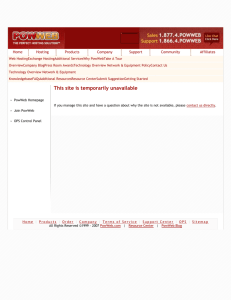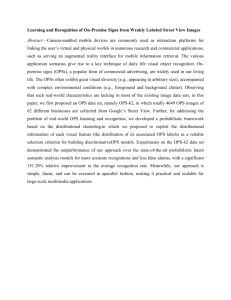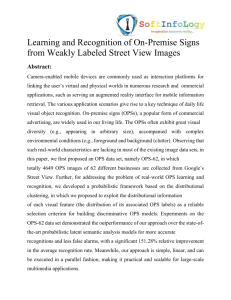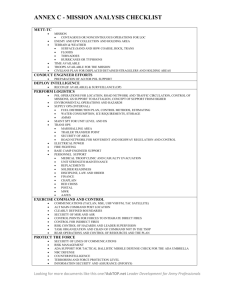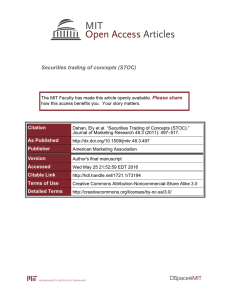Workshop #2 - Traffic Operations and Safety Laboratory
advertisement
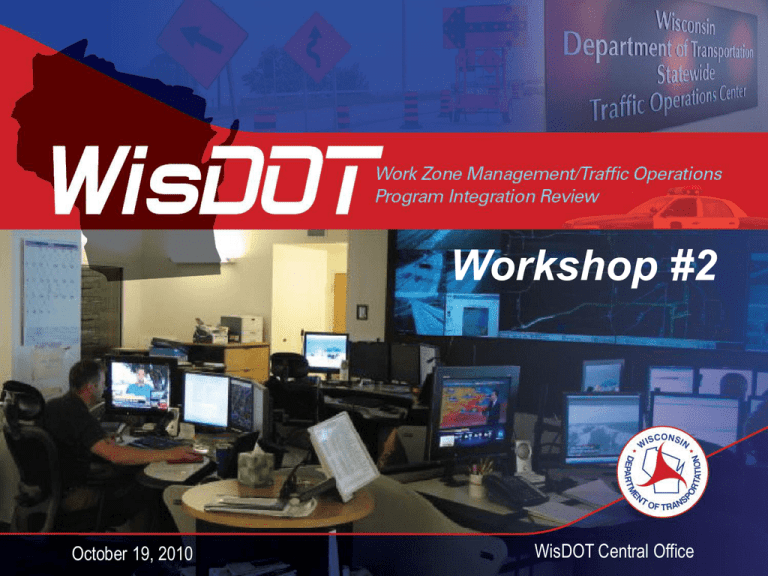
Workshop #2 October 19, 2010 WisDOT Central Office Overview of Workshop Welcome and Introductions Status Update of the Work Zone Management/Traffic Operations Program Integration Review Related Program and Project Updates Opportunity Focus Areas Discussion and Prioritization Next Steps Project Background Status Update of the Integration Review TASK 3 STOC Operations Model Assessment and Review TASK 2 Inventory and Environmental Scan of Traffic Ops Program TASK 5 Initial SWOT Analysis *Workshop #1 TASK 4 ITS Maintenance Program Review TASK 1 Project Management/Coordination TASK 6 Identify Opportunities *Workshop #2 * Executive Peers TASK 7 Strategic Plan *Present Final Plan Key Tasks and Major Deliverables Workshops: Technical memoranda/deliverables: 1st – initial review findings, draft documents, goals/direction 2nd – focus on key opportunities 3rd – focus on recommendations/content of Strategic Plan STOC Assessment ITS Maintenance Program Review SWOT Analysis Opportunities* Strategic Plan* *remaining deliverables Deliverables posted at: http://www.topslab.wisc.edu/workgroups/trafficOpsIntegration.html Related Program and Project Updates TOIP Communications Systems Layer Update Strategic Highway Safety Plan 2010-2012 SRF Consulting Improve Design and Operation of Intersections Reduce Speed Related Crashes Safer Work Zones Updated Traffic Signal Control Hardware and Software Opportunity Focus Areas Institutional Operational System and Data Integrity Operations Programmatic Alignment Performance Management/ Performance Monitoring External Focus (Traveler) For each theme: - Current Issues - Opportunities - Benefits - Risks of Not Seizing Opportunities - Are these the right opportunities? - What major concepts are missing? - Too many? Not enough? - What are the highest priority opportunities? - Champions - Dependencies Important Note: The following slides have been updated to reflect feedback received at the workshop about priorities and order of the focus areas. External Focus Opportunities Link program and capabilities to the customer (taxpayer) Viewed as #1 issue - cornerstone Demonstrate return on investment Travel time savings, reduced delay, safety Impact of program on the system (mobility, safety, ops investment vs. capital investment) Articulate successes! Day-to-day, major events Continue to strenthen relationship with freight industry Benefits: Show tangible impacts of operational investments Show direct link between operations and the customer Lets decision makers know how investments are benefitting their constituents Risks Remain internally focused Jeopardizes support from public and decision makers Performance Management Opportunities Demonstrate value and benefit of Traffic Operations program outputs – policy, planning, safety, decision support Establish robust processes for tracking/identifying System operational issues Communications issues Trends Identify the right internal and external measures Benefits: Data-driven decision making – proactive Support programmatic expansion, resource needs, and justify expenditures Accountability Demonstrate return on investment Risks - Program & resource reduction - Limited ability to respond to the hard questions - Reactive Operational Opportunities Better integrate business processes Re-examine statewide and regional operations roles Day to day ops and management leverage regional involvement for implementation-focused activities (WZ management) Align with TOIP needs and priorities Operational sustainability Define processes for implementation (consistency) Define relationships of systems/functions (architecture) Benefits: Better focus of operational roles Systems will support enhanced operations Defined operational direction – training, integration, implementation Proactive input to infrastructure needs Risks Focus on minor operational issues at the expense of larger operational issues Reactive operations planning Near-term vs. long term view BASELINE NEAR TERM FUTURE Current Functions Expanded Functions New Functions Incident Management Emergency Management Work Zone Management Traffic Management (Freeways) Traveler Information (511) Current Staff Current Partners Shared Communications Incident Management Emergency Management Work Zone Management Geographic Expansion of Traffic Management Traveler Information (511) ITS Implementation Traffic Signal Operations Additional Partners Performance Monitoring Linked Communications SUPPORT FOR ASSESSMENT Documents and Plans Roles and Responsibilities Interactions with Partners Operational Processes Existing Systems Agreements Policies and Guidelines Winter Operations Management RWIS Data Collection Freight Operations Mobile ATIS Functionality New ITS Devices Integrated Communications Performance Management SUPPORT FOR ASSESSMENT Documents and Plans Roles and Responsibilities Interactions with Partners Operational Processes Existing Systems Agreements Policies and Guidelines CHECKPOINT – ASSESSMENT CRITERIA Functional : systems, equipment, physical space Resources : staff, skills, partners, funds Readiness : operations and maintenance, sustainability, leverage opportunities, alignment with other processes, funding availability Institutional Opportunities Re-establish and communicate a consistent definition of STOC roles and capabilities “inreach” about data, capabilities, ops/decision support Illustrate and articulate connectivity and functions Establish common goals – systemwide focus Factor regional/statewide ops needs Elevate and multi-purpose the Traffic Ops capabilities “Dial Up/Stabilize/Dial Down” and link to funding and resources Benefits: Increased support/synergy: WZ, Safety, IM Better leverage tools, systems and resources Grow partnerships Demonstrate value and impact Risks - Limits visibility of full range of capabilities - Jeopardizes funding, resource or legislative support Systems and Data Integrity Opportunities Lifecycle challenges with current infrastructure Data integrity issues not easy to identify Consolidate and update central system to meet statewide needs Proactively identify system failure points and risks Benefits: More reliable data to support internal and external needs Better leverage data for real-time management needs System integrity = program integrity Use systems to help automate and support performance tracking Risks System reliability directly impacts travelers Limited capability to integrate or expand functions Operations Programmatic Alignment Opportunities Programmatically re-engineer Traffic Operations into other WisDOT operations areas Support SHSP goals – decision support, data, operational performance Expand operator interaction with IM (WSP Communications) Consolidate/eliminate redundancy (planning data collection) Incorporate “programmatic” opportunities into system requirements and needs (including CSL, data needs, reporting, etc.) Benefits: Multi-level support and functionality of Traffic Ops systems Traffic Ops viewed as integral partner, not peripheral capability Systemwide and agencywide approach – migrate from isolated operations needs Risks - One dimensional view of program capabilities - Perception that program is not integrated into other institutional objectives Prioritizing the Opportunities Timeframes and phasing Broad-based support How to garner support How to best align to achieve buy-in, consensus Champions for Opportunities Strategic Plan as a vehicle for: Highlighting priorities Synergies Dependencies Champions Next Steps Finalize Opportunities Strategic Plan Development Next Workshop – early December in conjunction with System Manager O&M Framework Questions? Project Contacts John Corbin, P.E., WiSDOT PM John.corbin@dot.state.wi.us Lisa Burgess – Consultant PM Lisa.burgess@kimley-horn.com
